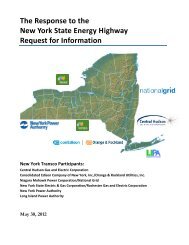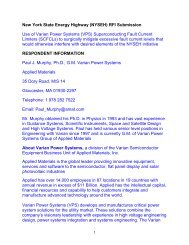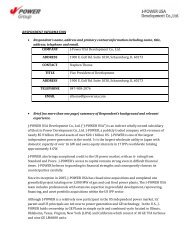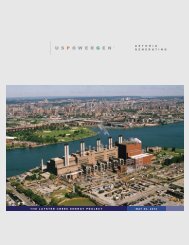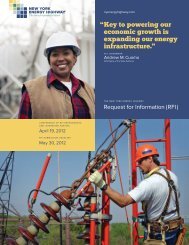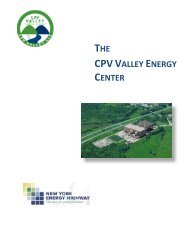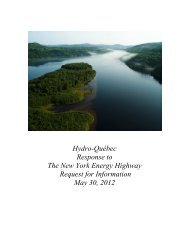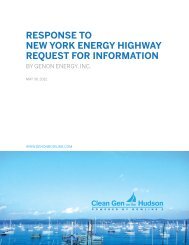Beacon Power, LLC Response to the New York Energy Highway ...
Beacon Power, LLC Response to the New York Energy Highway ...
Beacon Power, LLC Response to the New York Energy Highway ...
Create successful ePaper yourself
Turn your PDF publications into a flip-book with our unique Google optimized e-Paper software.
power at times when local demand would o<strong>the</strong>rwise cause transmission congestion. Alleviating<br />
congestion is achieved by s<strong>to</strong>ring energy during times of low demand, and releasing it when<br />
increased local demand would o<strong>the</strong>rwise cause an overload on <strong>the</strong> transmission line. In<br />
addition, co-locating <strong>the</strong> energy s<strong>to</strong>rage resource with an intermittent renewable resource such<br />
as wind can provide firming such that <strong>the</strong> renewable resource has reduced variability.<br />
B. Project Justification<br />
Using s<strong>to</strong>rage technologies <strong>to</strong> relieve transmission congestion meets <strong>the</strong> State’s goal of<br />
applying advanced technologies such as energy s<strong>to</strong>rage that benefit system performance and<br />
operations. This is accomplished by locally reducing transmission congestion with energy<br />
s<strong>to</strong>rage alone or in combination with providing firming of intermittent resources such as wind.<br />
Both stand alone energy s<strong>to</strong>rage projects, and <strong>the</strong> combination with a renewable energy<br />
resource solve <strong>the</strong> problem of transmission congestion with zero direct emissions. The use of<br />
s<strong>to</strong>rage <strong>to</strong> improve <strong>the</strong> existing transmission capability will 1) reduce constraints on <strong>the</strong> flow of<br />
electricity, 2) expand <strong>the</strong> diversity of power generation sources, 3) assure long-term reliability,<br />
4) contribute <strong>to</strong> an environmentally sustainable future for <strong>New</strong> <strong>York</strong> state.<br />
C. Financial Information<br />
The use of s<strong>to</strong>rage on <strong>the</strong> transmission and/or distribution system should be part of <strong>the</strong><br />
utility’s infrastructure and eligible for rate-based cost recovery. Companies, such as <strong>Beacon</strong><br />
<strong>Power</strong>, can sell turnkey s<strong>to</strong>rage solutions <strong>to</strong> <strong>the</strong> utility.<br />
D. Permit/Approval Process<br />
<strong>Beacon</strong> <strong>Power</strong>’s flywheels do not consume fuel nor produce particulates or o<strong>the</strong>r<br />
harmful emissions. This helps make it possible <strong>to</strong> rapidly permit and site a flywheel-based plant<br />
almost anywhere on <strong>the</strong> grid relatively close <strong>to</strong> a transmission or distribution line.<br />
III. Policy Recommendations<br />
<strong>Beacon</strong> <strong>Power</strong> suggests several policy recommendations increase <strong>the</strong> use of advanced energy<br />
s<strong>to</strong>rage technologies, such as flywheels, on <strong>the</strong> <strong>New</strong> <strong>York</strong> power grid.<br />
‣ Include energy s<strong>to</strong>rage technologies in <strong>the</strong> State’s Renewable Portfolio Standard.<br />
As discussed above, s<strong>to</strong>rage has zero direct emissions and is an enabler of additional<br />
renewable energy generation from sources such as wind and solar. Therefore, we recommend<br />
that <strong>the</strong> <strong>New</strong> <strong>York</strong> RPS be revised <strong>to</strong> include flywheel energy s<strong>to</strong>rage, and o<strong>the</strong>r advanced<br />
s<strong>to</strong>rage technologies, as an eligible electric generation source. In Massachusetts, flywheel<br />
7



